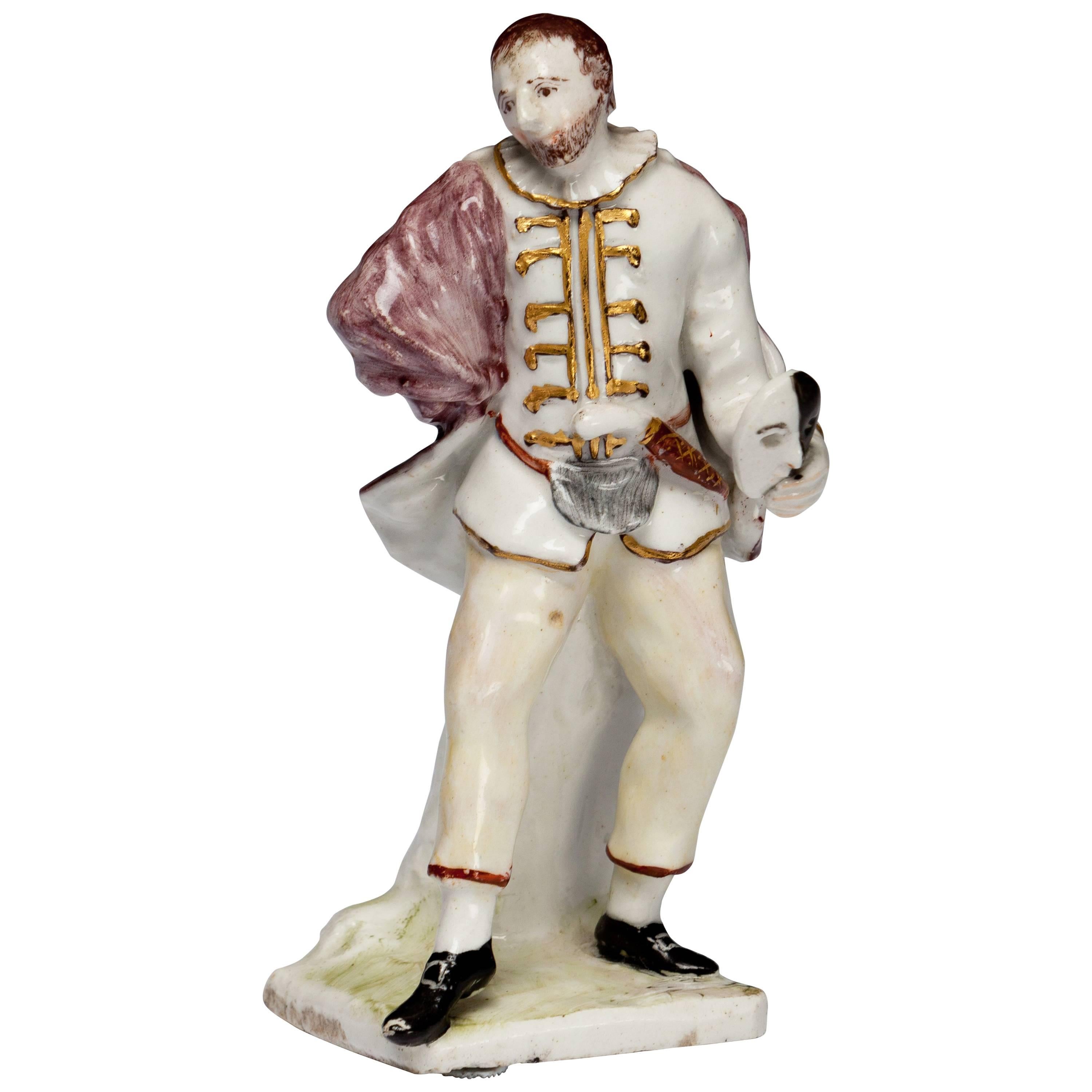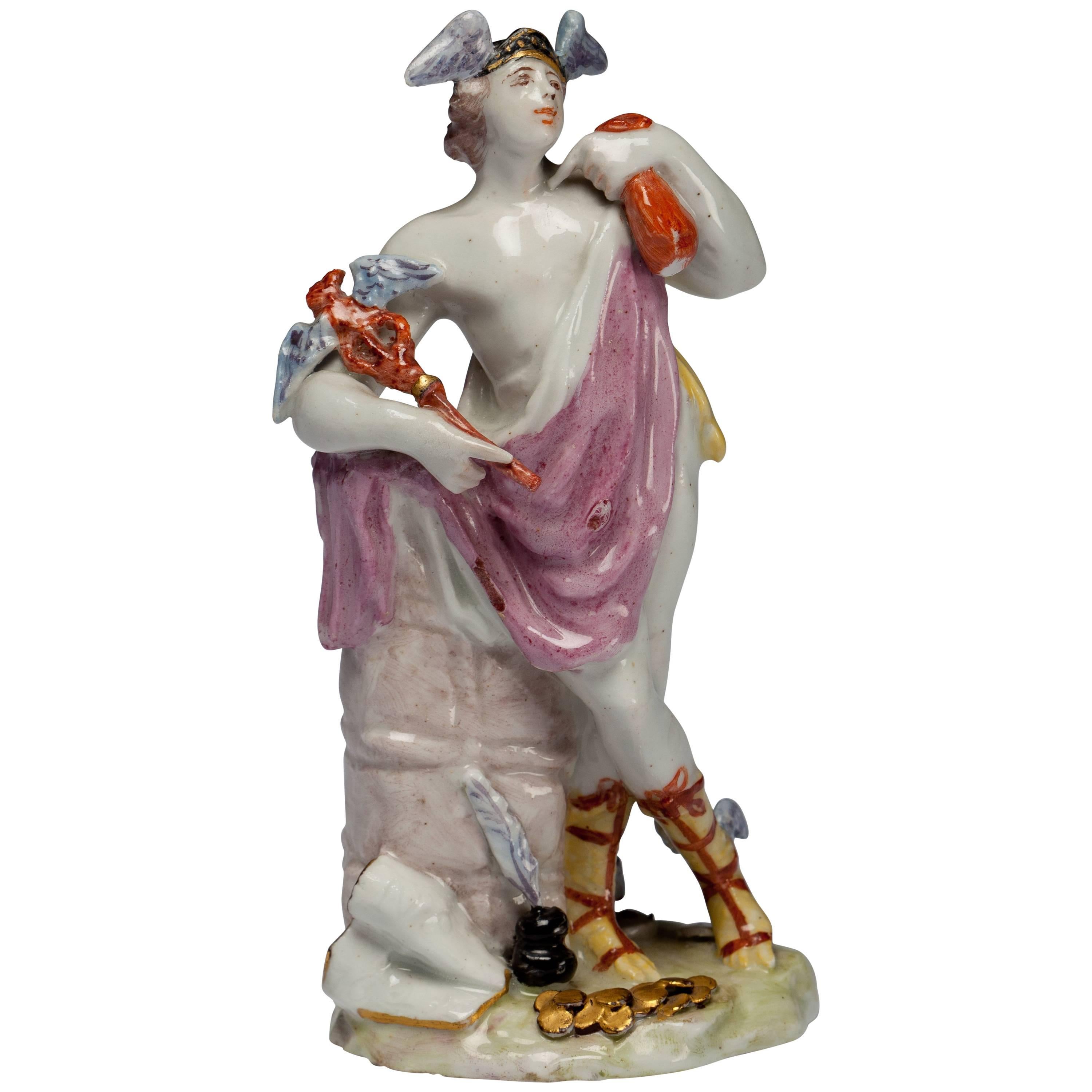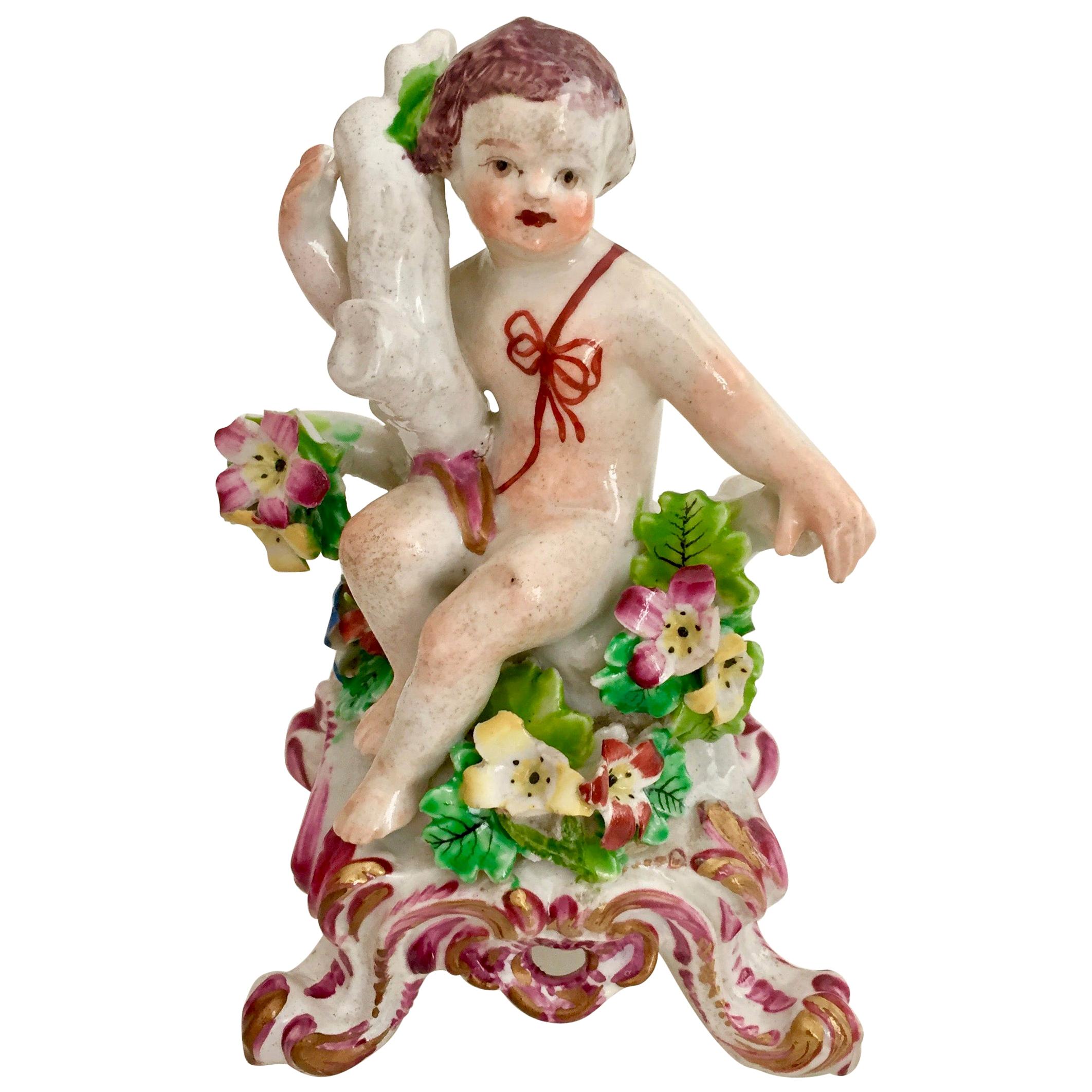Items Similar to Figure: David Garrick and the Shoeshine Boy, Bow Porcelain, circa 1751
Want more images or videos?
Request additional images or videos from the seller
1 of 8
Figure: David Garrick and the Shoeshine Boy, Bow Porcelain, circa 1751
About the Item
A fashionably dressed gentleman, almost certainly the actor David Garrick: he wears a white frockcoat, pink waistcoat and red breeches, all with embroided gilt enrichments and white stockings, one of which is incised with underglaze decoration. He stands with his hat under arm, right foot raised, and takes snuff from his right hand. A shoe-shine boy wearing a yellow jacket, red breeches, pink stockings and a brimmed hat, kneels to brush the gentleman’s shoes. All on a ‘grassy’ Rococo moulded base partially within a tree-stump which forms a support to the figure. Dense body; clear glaze. Straw translucency. Base wiped of glaze. Measures: H. 5.5 in (13.9 cm).
Provenance: Anon, Bonhams, London December 2010, Lot 107.
Another, as Gallant with Bootblack, about 1750, MFA, Boston, Gift Mr and Mrs Sigmund Katz, Accession #1988.575, the McEuen Collection; illustrated Transactions, English Porcelain Circle, (EPC) 1928, #1, Plate xix, and Yarbrough, 1996, Fig 59, p.39.
Figures of the fashionable en grande toilette were also produced at European factories and C18th and C19th figures en grande toilette appear to be relatively common.
- Creator:Bow Porcelain (Maker)
- Dimensions:Height: 6 in (15.24 cm)Width: 5.5 in (13.97 cm)Depth: 4 in (10.16 cm)
- Style:Neoclassical (Of the Period)
- Materials and Techniques:
- Place of Origin:
- Period:
- Date of Manufacture:circa 1751
- Condition:Repaired: Restoration to Garrick’s right arm, & left finger; Boy’s right hand; minor touch-ups to base.
- Seller Location:Melbourne, AU
- Reference Number:
About the Seller
5.0
Gold Seller
These expertly vetted sellers are highly rated and consistently exceed customer expectations.
Established in 2005
1stDibs seller since 2017
69 sales on 1stDibs
Typical response time: 3 hours
- ShippingRetrieving quote...Ships From: Melbourne, Australia
- Return PolicyA return for this item may be initiated within 14 days of delivery.
More From This SellerView All
- Figure of Pointing Boy by Bow Porcelain Factory, circa 1751By Bow PorcelainLocated in Melbourne, VictoriaPresumably based on the work of the Flemish sculptor François Duquesnoy (1597-1643), also known as Il Fiammingo. A small series of Chelsea figures from the late 1740s was also ba...Category
Antique Mid-18th Century English Neoclassical Figurative Sculptures
MaterialsPorcelain
- Figure, Sportsman Toper, Bow Porcelain Factory, circa 1751By Bow PorcelainLocated in Melbourne, VictoriaProbably an early prototype, the largely open base showing an apparently unique structure described by Watney as ‘a favourite primitive buttressed by a strong overall cone-shape and further strengthened by a cut-out additional layer inside the base in the manner of pastry making.’ (Freeman Collection, Forward, 1982). Toper is an old English word for a drunk. Annulet Mark. Prov: Taylor Coll, Albert Amor...Category
Antique Mid-18th Century English Neoclassical Figurative Sculptures
MaterialsPorcelain
- Figure 'Scapino, ' from the Commedia Dell'arte, Bow Porcelain, circa 1751By Bow PorcelainLocated in Melbourne, VictoriaScappino, or Scapin, a zany (zanni) character from the commedia dell'arte: a buffoon, schemer and scoundrel, and the title character in Molière's Les Fourberies de Scapin, first staged in 1671. The Bow figure shows him standing to right against a tree stump, right leg forward; right arm concealed in a tabarro (cape), and a mask in his left hand. He wears a white doublet, gilt frogged in the Hungarian manner, neck ruff, pale yellow-washed breeches above buckled shoes; a pouch on a red-brown strap and a dagger in a scabbard at the waist. Low square plinth base washed in typical pale Bow ‘lettuce’ green. No discernible translucency. H. 5.0 in (12.6 cm). Provenance: Taylor Collection; Simon Spero London, 2008; the Faith and Dewayne Perry Collection. The Scapino figure was presumably based on the Meissen modelled 1743-45 by Peter Reinicke, assisted by Käendler, and from the series produced for Johann Adlf II, Duke of Weissenfels, after an engraving by Francois Joullain (1662-1753) for Riccobin’s Historie du Théatre Italien, 1728. The modelling and features of the Bow figure suggest the work of the ‘Muses Modeller’, and the pallete, gilding and detail are also those of the muses modeller figures. This figure illustrated Bradshaw, 1992, as circa 1753, Plate 10 (A12), p.64. Scapino is depicted musically in William...Category
Antique Mid-18th Century English Neoclassical Figurative Sculptures
MaterialsPorcelain
- Figure, Mercury, Bow Porcelain, circa 1748By Bow PorcelainLocated in Melbourne, VictoriaHe wears a winged helmet and sandals, a loosely draped pink, white, and yellow washed cloak over a short tunic, and leans arrogantly against bales, his message sack over his left sho...Category
Antique Mid-18th Century English Neoclassical Figurative Sculptures
MaterialsPorcelain
- Figure of The Vintner's Companion, Bow Porcelain Factory, circa 1748By Bow PorcelainLocated in Melbourne, VictoriaMoulded in a dense body in typical muses modeller style and with slightly drab glaze. She stands by a fruiting vinestock and carries an open basket of grapes in her right hand, her e...Category
Antique Mid-18th Century English Neoclassical Figurative Sculptures
MaterialsPorcelain
- Figure: Female Pedlar, Possibly Peg Woffington, Bow Porcelain, circa 1758By Bow PorcelainLocated in Melbourne, VictoriaOn a mound base decorated with painted floral sprigs. She wears a pale pink-mauve washed shift with iron-red sleeves and cloak, pale mauve and pink stomacher and a sprigged white shi...Category
Antique Late 18th Century English Neoclassical Figurative Sculptures
MaterialsPorcelain
You May Also Like
- Bow Porcelain Figure of Boy or Putto on C-Scroll Base, Georgian circa 1760By Bow PorcelainLocated in London, GBThis is a wonderful little figure of a boy or putto made by the Bow Porcelain factory in about 1760. The Bow Porcelain Factory was one of the first potteries in Britain to make soft...Category
Antique 1760s English Rococo Figurative Sculptures
MaterialsPorcelain
- Bow Porcelain Figure of Venus with Doves, Rococo, 1756-1764By Bow PorcelainLocated in London, GBThis is a rare and beautiful figure of Venus with two doves, made by the bow porcelain factory between 1756 and 1764. We see Venus standing holding her robe with one hand, a flower p...Category
Antique 1760s English Rococo Figurative Sculptures
MaterialsPorcelain
- Bow Complete Set of Porcelain Figures "The Four Elements", Rococo, circa 1765By Bow PorcelainLocated in London, GBThis is a very rare and impressive complete set of large figures called The Four Elements, made by the Bow Porcelain factory in about 1765. It consists of Ceres representing Earth, V...Category
Antique 1760s English Rococo Figurative Sculptures
MaterialsPorcelain
- Bow Porcelain Figure of Juno with Eagle 'Jupiter', Rococo Ca 1765By Bow PorcelainLocated in London, GBThis is a very rare and impressive large figure of Juno with an eagle, made by the Bow Porcelain factory in about 1765. This figure formed part of a series of the Four Elements, with...Category
Antique 1760s English Rococo Figurative Sculptures
MaterialsPorcelain
- Antique 18th Century Bow English Porcelain Figure of a Flute PlayerBy Bow PorcelainLocated in Philadelphia, PAAn antique English porcelain figurine. By Bow. In the form of a boy clothed in 18th century garb and holding a flute. We've noted losse...Category
Antique 18th Century English Georgian Porcelain
MaterialsPorcelain
- Bow Pair of Porcelain Figures, Arlecchino and Columbina, Rococo ca 1758By Bow PorcelainLocated in London, GBThis is a wonderful pair of figures of Arlecchino and Columbina, made by the Bow Porcelain factory in about 1758. These figures formed part of a series of the Commedia dell'Arte, a very popular series of theatrical figures that served as decoration at the dinner table in the 18th Century. The Bow Porcelain Factory was one of the first potteries in Britain to make soft paste porcelain, and most probably the very first to use bone ash, which later got perfected by Josiah Spode to what is now the universally used "bone china". Bow was the main competitor of the Chelsea Porcelain Factory, but where Chelsea made very fine slipcast porcelain, Bow made a different soft paste porcelain that tended to be softer and could be pressed into moulds. Bow served a larger public generally at lower prices. The factory was only in operation between 1743 and 1774, after which the tradition got incorporated into some of the later famous potteries such as Worcester and Derby. These figures were used to adorn the dinner table when dessert was served; groups of figures served to express something about the host, the guests, or to direct the conversation. The Italian Commedia Dell'Arte, a comical form of masked theatre, was very popular in those days and Bow copied many figures of the German Meissen series that were brought out in the decades before. This pair dates from about 1758, which was at the height of Bow's ability to make beautiful figurines often copied from Chelsea or Meissen. The pair is modelled after a Meissen pair by Kaendler. The porcelain is translucent with a beautiful milky glaze - Bow was probably the first pottery using bone in its porcelain recipe. Arlecchino (Harlequin) is playing the bagpipes, dressed in an odd costume of mismatched chintz and playing cards and wearing a funny black trumpet...Category
Antique 1750s English Rococo Figurative Sculptures
MaterialsPorcelain





